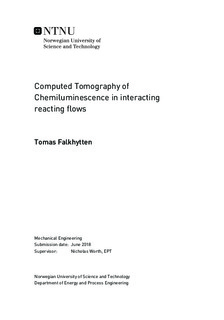Computed Tomography of Chemiluminescence in interacting reacting flows
Master thesis
Permanent lenke
http://hdl.handle.net/11250/2508087Utgivelsesdato
2018Metadata
Vis full innførselSamlinger
Sammendrag
Computed Tomography of OH* Chemiluminescence of a single flame confined by an annular combustion chamber have been demonstrated in this thesis. 3D heat release structures were reconstructed for both unforced and acoustically forced flames.
A phantom study was performed. The methodology of the study was first thoroughly presented, before a parametric study was conducted. How camera configurations, calibration errors and reflections influenced reconstruction qualities of the implemented tomographic methods were investigated. These tests revealed that maximizing view width of the camera configuration was crucial to the final reconstruction quality. They also indicated strong coherence between reconstruction quality and processing sequence of erroneous data.
A mock experiment was used to investigate possible problems with camera calibrations. The tests showed that refraction due to the annular quartz enclosure deteriorated the calibration accuracy. The experimental methods of the Computed Tomography of OH* Chemiluminescence of the single flame confined in an annular combustion chamber were then presented. Acoustic drivers were used to force an azimuthal instability mode in the annular chamber.
3D heat release structures were reconstructed for both an unforced, and acoustically forced flame. For the unforced flame, the mean structure showed asymmetries in the heat release likely caused by limited view width and inaccurate bluff-body positioning in the burner. 12 phase-averaged volumes were reconstructed for the acoustically forced flame, spanning over a full oscillation cycle of an azimuthal mode with a mean spin ratio, SR=0.26.
The results showed complicated 3D flame dynamics for acoustically forced flame. Based on the azimuthal mode characterization, the complex flame dynamics is caused by the ACW spinning component of the azimuthal mode hitting the flame brush from the side.
Despite promising results, further work needs to be done to validate the results with other experimental methods like OH-PLIF, and improve camera calibrations procedures.
